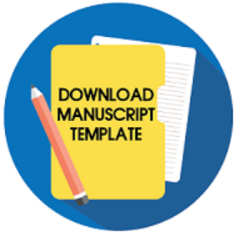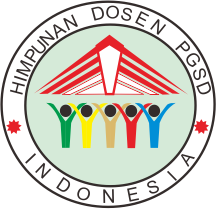Increased Skills and Liveliness Writing Paragraphs Through the Relay Writing Method Helping Elementary School Students
This study aims to increase the activeness and skill of paragraph writing through the straw media-assisted writing relay method in grade VI B SDN 09 Rangkang Bengkayang, West Kalimantan. The research method is in the form of Classroom Action Research (PTK) with 26 students, 13 males and 13 females. The research instrument was in the form of a performance test. Data collection techniques are in the form of observation of activeness and results of paragraph writing skills. Qualitative descriptive method for data analysis. The results of the research on the first cycle of paragraph writing skills were 76.92%, the class average was 73.42. In Cycle II, paragraph writing skills increased by 23.08% with a significant graduation rate of 100% with an average class of 90.42. The presentation of the activeness of the first cycle was 75% of the good category, and the second cycle increased significantly by 100% of the very good category. It was concluded that the application of the writing relay method assisted by straw media can increase the activeness and skill of paragraph writing in grade VI students of SDN 09 Rangkang. The findings imply that creative and collaborative learning strategies, such as the writing relay method with media support, can be an effective alternative for teachers to foster active participation and improve students’ writing competence. This approach not only enhances learning outcomes but also motivates students to engage more in language learning activities, and thus can be adopted in broader classroom contexts as a practical model for teaching writing in elementary schools.
Downloads
Ahadianingsih, M. N. (2021). The Use of Straw String Media to Improve Pre‐Writing Skills for Children With Intellectual Disability. JASSI ANAKKU. Retrieved from https://ejournal.upi.edu/index.php/jassi/article/view/39513
Amrullah, Karim, & Maulana. (2015). The Use of Estafet Writing with Chained Picture to Improve Student Writing Skill on Narrative Text (Thesis). https://digilibadmin.unismuh.ac.id/upload/5779-Full_Text.pdf
Asmani, J. M. M. (2016). Effective Tips for Cooperative Learning: Active, Creative, and Not Boring Learning. Diva Press
Chen, W., & Yu, S. (2019). Implementing collaborative writing in teacher-centered classroom contexts: Student beliefs and perceptions. Language Awareness, 28(4), 247–267. https://doi.org/10.1080/09658416.2019.1675680
Churiyah, Y. (2011). Analysis of the level of understanding of elementary school students towards the use of spelling. Journal of the University of Education Indonesia, number 11April. http://file.upi.edu/Direktori/JURNAL/PENDIDIKAN_DASAR/Nomor_11-April_2009/ANALISIS_TINGKAT_PEMAHAMAN_SISWA_SEKOLAH_DASAR_TERHADAP_PENGGUNAAN_EJAAN.pdf.
Denham, S.H., Betti, M.J., & Hussein, N.M. (2021). The effect of using estafet writing technique to enhance students' compositional efficiency. English Language and Literature Studies. DOI: 10.22158/elsr.v2n1p1
Fadlilah, H. N., Endang, U., & Yuniartin, T. (2019). Improving students' writing skills through using the Chain Writing method (Relay Writing). Bestari: Journal of Islamic Education Studies (16), 1(3). https://www.riset-iaid.net/index.php/bestari/article/view/395
Fauzi, M. R. (2020). Analysis of Reading Comprehension Ability of High Class Elementary School Students by Determining the Main Idea of the Paragraph Through the Concentrated Language Encounter (CLE) Method: Collase (Creative of Learning Students Elementary Education), 3(4), 147-161. DOI: https://doi.org/10.22460/collase.v3i4.4851.
Hasanah, Z., & Himami, A. S. (2021). Cooperative Learning Model in Fostering Student Learning Activity. Irsyaduna: Journal of Student Studies, 1(1), 1-13. DOI: https://doi.org/10.54437/irsyaduna.v1i1.236.
Islamiah, F.N., Azis, S.A., & Latief, S.A.W. (2023). Meningkatkan Kemampuan Menulis Melalui Metode Estafet Writing pada Siswa Kelas IV SD Inpres Teladan Merpati Kecamatan Bantaeng Kabupaten Bantaeng. BERSATU: Jurnal Pendidikan Bhinneka Tunggal Ika. https://doi.org/10.51903/bersatu.v1i5.388
Jannah, D. R. N., & Atmojo, I. R. W. (2022). Digital Media in Empowering 21st Century Critical Thinking Skills in Science Learning in Elementary Schools. Basicedu Journal, 6(1), 1064–1074. https://doi.org/10.31004/basicedu.v6i1.21
Jannah, M., Dewi, N. K., & Oktaviyanti, I. (2021). Analysis of Teachers' Difficulties in Preparing Learning Implementation Plans (RPP) at SDN 05 Ampenan. Primary Education Journal, 2(1), 42–50. https://doi.org/10.29303/pendas.v2i1.100
Melyaty, S.E. (2012). Penggunaan Media Sedotan Plastik untuk Meningkatkan Hasil Belajar Tema Pengalaman di Kelas III SD. Jurnal Penelitian PGSD, Universitas Negeri Surabaya. https://ejournal.unesa.ac.id/index.php/jurnal-penelitian-pgsd/article/download/2374/1469/4232
Pahleviannur, M. R., Mudrikah, S., Mulyono, H., Bano, V. O., Rizqi, M., Syahrul, M., ... & Aini, K. (2022). Classroom Action Research. Pradina Pustaka
Pangestu, P., & Santi, A. U. P. (2016). The Influence of Realistic Mathematics Education on a Fun Learning Atmosphere in Elementary School Mathematics Lessons. FIBONACCI: Journal of Mathematics and Mathematics Education, 2(2), 58. https://doi.org/10.24853/fbc.2.2.58-71
Penso, S. (2002). Pedagogical Content Knowledge: How do student teachers identify and describe the causes of their pupils' learning difficulties? Asia-Pacific Journal of Teacher Education, 30(1), 25–37. https://doi.org/10.1080/13598660120114959
Pingge, H. D. (2016). Factors that affect the learning outcomes of elementary school students in Tambolaka City District. Journal of Prima Edukasia, 4(2), 134. https://doi.org/10.21831/jpe.v4i2.6458
Pramesti, U. D., Pramesti, U. D., & Effendi, E. E. (2018). Improvement of Paragraph Writing Learning Outcomes in Indonesian Language at Padang State University through the Stad (Student Team-Achievement Divisions) model of the Chain Writing Method. KREDO: Scientific Journal of Language and Literature, 2(1). https://doi.org/10.24176/kredo.v2i1.2565
Prata, M. J., De Sousa, B., Festas, I., & Oliveira, A. L. (2019). Cooperative methods and self-regulated strategies development for argumentative writing. The Journal of Educational Research, 112(1), 12–27. https://doi.org/10.1080/00220671.2018.1427037
Primasari, Y., Sari, H.P., & Sutanti, N. (2021). The chain writing method in learning writing for information technology faculty students: the effectiveness. JARES (Journal of Academic Research and Sciences). https://repository.unisbablitar.ac.id/id/eprint/62/2/CHAIN%20WRITING.pdf?utm_source=chatgpt.com
Putri, E. N., & Purnami, A. S. (2018). Increased activeness and learning outcomes through the Discovery learning model. Trihayu: Journal of Elementary Education, 4(2). DOI: https://doi.org/10.30738/trihayu.v4i2.2245
Rachmah, L. L., Farantika, D., & Prawinda, R. A. (2022). STEAM learning with loose parts media to stimulate children's development. Journal of Education: Research and Conceptual, 6(3), 466 DOI: https://doi.org/10.28926/riset_konseptual.v6i3.535
Rosita, R., Safitri, R. D., Suwarma, D. M., Muyassaroh, I., & Jenuri, J. (2024). Constructivism Approach to Improving Elementary School Student Learning Outcomes. Journal of Basic Education Review: Journal of Education Studies and Research Outcomes, 10(3), 238–247. https://doi.org/10.26740/jrpd.v10n3.p238-247
Schunk, D. H., & Swartz, C. W. (1993). Writing strategy instruction with gifted students: Effects of goals and feedback on self‐efficacy and skills. Roeper Review, 15(4), 225–230. https://doi.org/10.1080/02783199309553512
Su, C.-Y., & Chiu, C.-H. (2021). Perceived Enjoyment and Attractiveness Influence Taiwanese Elementary School Students' Intention to Use Interactive Video Learning. International Journal of Human–Computer Interaction, 37(6), 574–583. https://doi.org/10.1080/10447318.2020.1841423
Sunarsih, W. (2021). CTL (Contextual Teach and Learning) Learning, Learning to Write News Easier. Adab Publisher
Suryansah, T., & Suwarjo, S. (2016). Development of learning videos to improve motivation and cognitive learning outcomes of grade IV elementary school students. Journal of Prima Edukasia, 4(2), 209. https://doi.org/10.21831/jpe.v4i2.8393
Suyuti, S., Wahyuningrum, P. M. E., Jamil, M. A., Nawawi, M. L., Aditia, D., & Ayu Lia Rusmayani, N. G. (2023). Analysis of the Effectiveness of the Use of Technology in Education on Improving Learning Outcomes. Journal on Education, 6(1), 1–11. https://doi.org/10.31004/joe.v6i1.2908
Taheri, H., Sadighi, F., Bagheri, M. S., & Bavali, M. (2020). Investigating the relationship between Iranian EFL learners' use of language learning strategies and foreign language skills achievement. Cogent Arts & Humanities, 7(1), 1710944. https://doi.org/10.1080/23311983.2019.1710944
Tangney, S. (2014). Student-centred learning: A humanist perspective. Teaching in Higher Education, 19(3), 266–275. https://doi.org/10.1080/13562517.2013.860099
Vogrinc, J., & Zuljan, M. V. (2009). Action research in schools – an important factor in teachers' professional development. Educational Studies, 35(1), 53–63. https://doi.org/10.1080/03055690802470399
Wahidah, F. (2021). Efforts to Improve Fine Motor Skills in Early Childhood (Classroom Action Research at RA Mutiara Hati). Childhood Education Journal of Early Childhood Education, 2(2), 138–150. https://doi.org/10.53515/CJI.2021.2.2.138-150
White, R. (2011). A sociocultural understanding of mediated learning, peer cooperation and emotional well-being. Emotional and Behavioural Difficulties, 16(1), 15–33.
Copyright (c) 2025 Alina Akit, Setiawan Edi Wibowo

This work is licensed under a Creative Commons Attribution-ShareAlike 4.0 International License.
The copyright of the received article shall be assigned to the journal as the publisher of the journal. The intended copyright includes the right to publish the article in various forms (including reprints). The journal maintains the publishing rights to the published articles.

Jurnal Prima Edukasia by http://journal.uny.ac.id/index.php/jpe/index is licensed under a Creative Commons Attribution-ShareAlike 4.0 International License.


























